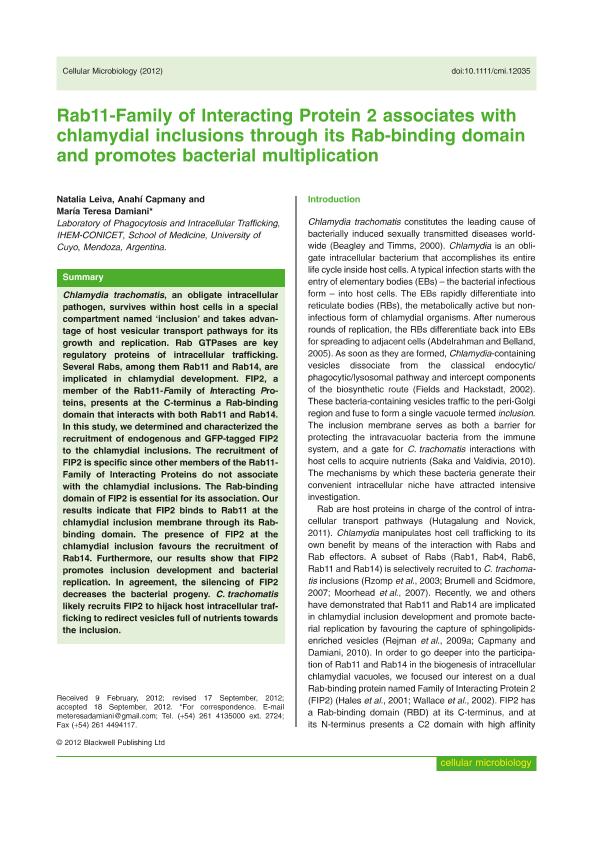Mostrar el registro sencillo del ítem
dc.contributor.author
Leiva, Natalia Lorena

dc.contributor.author
Capmany, Anahi

dc.contributor.author
Damiani, Maria Teresa
dc.date.available
2016-12-26T18:43:24Z
dc.date.issued
2012-11-01
dc.identifier.citation
Leiva, Natalia Lorena; Capmany, Anahi; Damiani, Maria Teresa; Rab11-Family of Interacting Protein 2 associates with chlamydial inclusions through its Rab-binding domain and promotes bacterial multiplication; Wiley; Cellular Microbiology; 15; 1; 1-11-2012; 114-129
dc.identifier.issn
1462-5814
dc.identifier.uri
http://hdl.handle.net/11336/10173
dc.description.abstract
Chlamydia trachomatis, an obligate intracellular pathogen, survives within host cells in a special compartment named ‘inclusion’ and takes advantage of host vesicular transport pathways for its growth and replication. Rab GTPases are key regulatory proteins of intracellular trafficking. Several Rabs, among them Rab11 and Rab14, are implicated in chlamydial development. FIP2, a member of the Rab11-Family of Interacting Proteins, presents at the C-terminus a Rab-binding domain that interacts with both Rab11 and Rab14. In this study, we determined and characterized the recruitment of endogenous and GFP-tagged FIP2 to the chlamydial inclusions. The recruitment of FIP2 is specific since other members of the Rab11- Family of Interacting Proteins do not associate with the chlamydial inclusions. The Rab-binding domain of FIP2 is essential for its association. Our results indicate that FIP2 binds to Rab11 at the chlamydial inclusion membrane through its Rabbinding domain. The presence of FIP2 at the chlamydial inclusion favours the recruitment of Rab14. Furthermore, our results show that FIP2 promotes inclusion development and bacterial replication. In agreement, the silencing of FIP2 decreases the bacterial progeny. C. trachomatis likely recruits FIP2 to hijack host intracellular traf- ficking to redirect vesicles full of nutrients towards the inclusion.
dc.format
application/pdf
dc.language.iso
eng
dc.publisher
Wiley

dc.rights
info:eu-repo/semantics/openAccess
dc.rights.uri
https://creativecommons.org/licenses/by-nc-sa/2.5/ar/
dc.subject
Fip2
dc.subject
Chlamydia Trachomatis
dc.subject
Intracellular Transport
dc.subject
Chlamydial Inclusions
dc.subject.classification
Biología Celular, Microbiología

dc.subject.classification
Ciencias Biológicas

dc.subject.classification
CIENCIAS NATURALES Y EXACTAS

dc.title
Rab11-Family of Interacting Protein 2 associates with chlamydial inclusions through its Rab-binding domain and promotes bacterial multiplication
dc.type
info:eu-repo/semantics/article
dc.type
info:ar-repo/semantics/artículo
dc.type
info:eu-repo/semantics/publishedVersion
dc.date.updated
2016-09-19T18:48:24Z
dc.journal.volume
15
dc.journal.number
1
dc.journal.pagination
114-129
dc.journal.pais
Reino Unido

dc.journal.ciudad
Londres
dc.description.fil
Fil: Leiva, Natalia Lorena. Consejo Nacional de Investigaciones Científicas y Técnicas. Centro Científico Tecnológico Mendoza. Instituto Histologia y Embriología de Mendoza "Dr. M. Burgos"; Argentina. Universidad Nacional de Cuyo. Facultad de Ciencias Médicas; Argentina
dc.description.fil
Fil: Capmany, Anahi. Consejo Nacional de Investigaciones Científicas y Técnicas. Centro Científico Tecnológico Mendoza. Instituto Histologia y Embriología de Mendoza "Dr. M. Burgos"; Argentina. Universidad Nacional de Cuyo. Facultad de Ciencias Médicas; Argentina
dc.description.fil
Fil: Damiani, Maria Teresa. Consejo Nacional de Investigaciones Científicas y Técnicas. Centro Científico Tecnológico Mendoza. Instituto Histologia y Embriología de Mendoza "Dr. M. Burgos"; Argentina. Universidad Nacional de Cuyo. Facultad de Ciencias Médicas; Argentina
dc.journal.title
Cellular Microbiology
dc.relation.alternativeid
info:eu-repo/semantics/altIdentifier/doi/http://dx.doi.org/10.1111/cmi.12035
dc.relation.alternativeid
info:eu-repo/semantics/altIdentifier/url/http://onlinelibrary.wiley.com/doi/10.1111/cmi.12035/abstract
Archivos asociados
